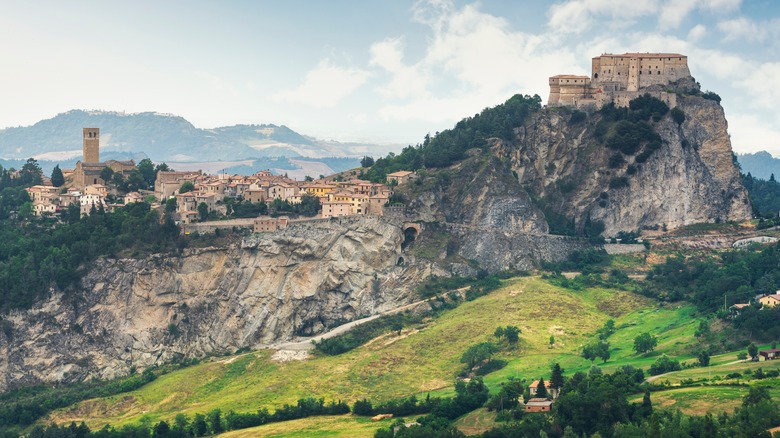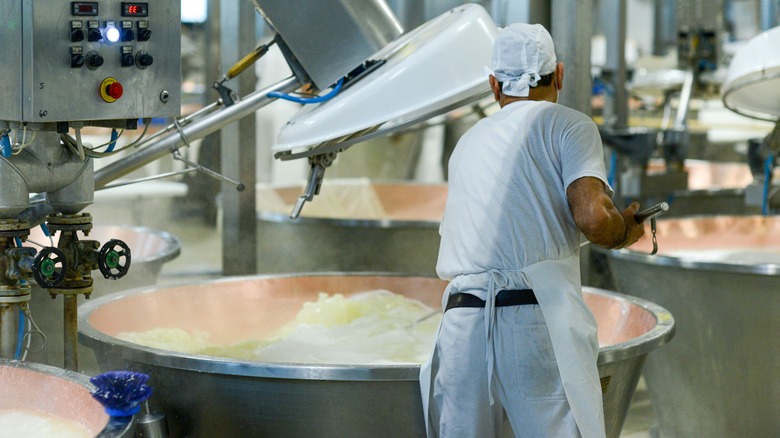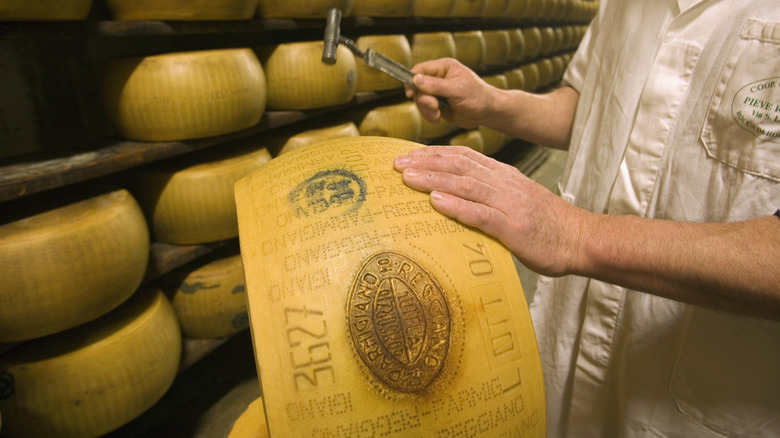4 Fascinating Facts About Parmigiano-Reggiano We Learned From The Pasta Queen
Nadia Caterina Munno is an NY Times best-selling author, cook, entrepreneur, and social media influencer known as The Pasta Queen. Munno says her goal is to become the Italian Martha Stewart. With her impressive combined social media following of over 7 million, enormous resume, and newly released television series, "The Pasta Queen" on Amazon Prime, you could say that she's already there.
In the penultimate episode of the series, Munno makes her "rebellious version" of Lasagna Verde, or Green Lasagna, a dish native to the Emilia-Romagna region in Northern Italy. During the making of the dish, with a little TV magic, Munno and her father Tonino took a side quest to San Possidonio to dive into the delicious world of Parmigiano Reggiano. On the walk up to the Parmigiano Reggiano production facility, Munno can hardly contain her excitement, telling her dad, "I think Parmiagiano is the most eaten food ... in every Italian family." That's probably true in the Tasting Table family too.
All authentic Parmigiano Reggiano comes from one place
Parmigiano Reggiano, aka The King of Cheeses, is so rooted in Emilia-Romagna that it's named after two local provinces, Parma and Reggio Emilia, where it was first produced. An EU court deigned Parmigiano Reggiano a Protected Designation of Origin (PDO), meaning authentic Parmigiano-Reggiano can only be made exclusively in this Northern Italian region.
According to The Pasta Queen, Emilia-Romagna cranks out over 3.7 million wheels of Parmigiano Reggiano each year. It's hard to say how many people one wheel can feed, but at nearly 100-pounds per wheel, you can at least guesstimate that the number is not in the single digits. Munno also claims that touching a wheel of Parmigiano Reggiano brings good luck. So the next time you find yourself standing next to a wheel of the Italian hard cheese, give it a little high five.
Parmigiano Reggiano is cooked in copper vats
Parmigiano Reggiano is a hard Italian cheese made from cow's milk. Although its sister cheese, Pecorino Romano, is sometimes used as a substitute because it offers a lot of the same qualities, we don't advise going this route. Pecorino is made with goat milk and tends to be bolder and saltier than Parmigiano Reggiano, so if you want to keep your dish authentic, stick with the Parmigiano.
Parmigiano starts out as cow's milk and is boiled at about 130 degrees Fahrenheit in large copper cauldrons that look kind of like vintage bathtubs. Each vat hold about 550 liters of milk, which is how much liquid you need to produce a wheel of Parmigiano Reggiano. Once the curds sink to the bottom and coagulate, they form one large mass of cheese that is ready to be removed from the tub. The Parmigiano mass is removed using linen cloths, dunked into water to remove excess whey, and then dropped into a circular mold to make the enormous Parmigiano wheel we know and love. According to Maurizio — the Vice President of La Cappelletta, which Munno tours during the episode — this is "day zero" of the wheel's life.
It's not authentic if it's not branded properly
In the first few hours of its life, the Parmigiano Reggiano is ready for its iconic marks of origin. The stenciled dotted branding spanning across the entire rind helps differentiate authentic, Italian-made Parmigiano Reggiano from the fakers. So the next time you're shopping for authentic parmesan, look to the rind to find remnants of the Parmigiano Reggiano name, PDO, and Consortium inscriptions (which means it's been certified by the Italian Ministry of Agricultural, Food, and Forestry Policies), its dairy identification number, the month and year the cheese was produced, as well as identification mark showing which plant it was produced in. To simplify, look for rinds with a ton of writing and numbers, and you should be good to go.
When the cheese is ready to be marked, they wrap an official brand belt around the cheese wheels, featuring dotted inscriptions of all the information mentioned above. The belt slips between the outside of the cheese and the mold, and then for the best part: The dairyman takes a mallet and whacks the mold to help the cheese distribute evenly. As the crust takes form in the structure, the rind will push up against the branding belt, causing the inscription to permanently imprint into the hard surface.
Every wheel of Parmigiano Reggiano needs to pass a test
Approximately 12 months after "day zero" of the wheel's life, the Parmigiano Reggiano Consortium sends inspectors to come test each wheel to make sure the cheese holds up to its rigorous standards. In order to test the wheels, inspectors pull them off the shelf and take a small hammer to the rinds. They test the circumference, tops, and bottoms, tapping away while listening to the sounds of the cheese. Ultimately, what they're looking for is to make sure that there are no cracks in the rind. Inspectors also use a thin, long cheese screw to poke a little hole into the wheel to test if the cheese smells as it should.
One year is the minimum time of maturation for Parmigiano Reggiano, and it's when inspectors can safely decide whether that specific wheel is worthy of the legally protected Parmigiano Reggiano name. If the trained ear of the inspector picks up that there's a quality control issue with the wheel of cheese, it is considered compromised and is unceremoniously stripped of all of the branding marks on the rind. If the cheese passes inspection, it get it's final fire branding to signify that it's not only real Parmigiano Reggiano, but it's real good Parmigiano Reggiano, and it then continues aging for another year or two.




